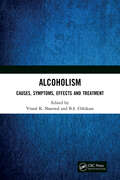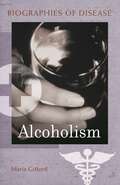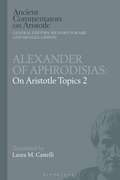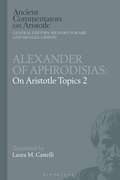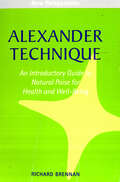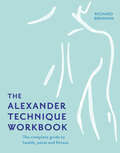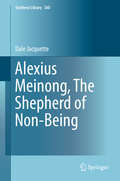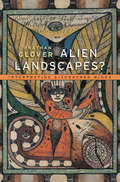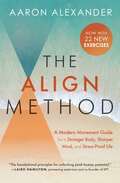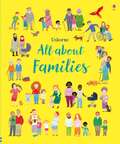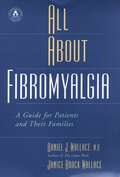- Table View
- List View
Alcoholism: Causes, Symptoms, Effects and Treatment
by Dr Vinod K. Shanwal And Dr. B. S. ChhikaraThe book includes research on multi-dimensional aspects of problems related to alcohol. The chapters cover a wide range of topics on the theme of Alcoholism, ranging from reasons and factors that induce alcoholism, to health risks and finally possible medical, psychological and alternative remedial measures. Various factors such as genetics, childhood influences, antisocial behaviour, and personality traits contribute to this menace of alcoholism. Cultural values, beliefs, and childhood experiences to govern thought process are indirectly related to earlier stages of alcohol addiction. Family history and life stress have implications on an individual's susceptibility to alcohol addiction. Personality traits influence the addiction in individuals. The treatment of alcoholism involves different therapies besides medicines for comprehensive and smooth recovery of the person. The important inducing factors, impact on society, individual, brain, family, nutritional deficiency and possible therapies such as body psychotherapies, herbal and natural therapy have been covered in the book in hope of a comprehensive solution.Note: T& F does not sell or distribute the Hardback in India, Pakistan, Nepal, Bhutan, Bangladesh and Sri Lanka.
Alcoholism (Biographies of Disease)
by Maria L. GiffordAn intriguing look at the history of alcoholism and its dramatic effects, from the first fermented grape to current advances in genetic research.Alcoholism tells the story of a disease familiar to many yet not well understood. It is the first "biography" of alcohol abuse that gauges its devastating effects on the body, the family, the economy, and the community.Alcoholism provides the latest understanding of the disease as a behavioral dysfunction and a biological condition. Coverage includes the origins of alcohol and the discovery of alcoholism as a medical disease; the biology of alcoholism and its effects on the body; and current diagnostic and treatment methods for alcoholism. In addition, the book explores the effects on society of such alcoholism-related problems as domestic abuse, fetal alcohol syndrome, drunk driving, and suicide, as well as promising new directions in alcoholism research, awareness, treatment, and prevention.
Alcoholism: Causes, Symptoms, Effects and Treatment
by Vinod K. Shanwal B. S. ChhikaraThe book includes research on multi-dimensional aspects of problems related to alcohol. The chapters cover a wide range of topics on the theme of Alcoholism, ranging from reasons and factors that induce alcoholism, to health risks and finally possible medical, psychological and alternative remedial measures. Various factors such as genetics, childhood influences, antisocial behaviour, and personality traits contribute to this menace of alcoholism. Cultural values, beliefs, and childhood experiences to govern thought process are indirectly related to earlier stages of alcohol addiction. Family history and life stress have implications on an individual's susceptibility to alcohol addiction. Personality traits influence the addiction in individuals. The treatment of alcoholism involves different therapies besides medicines for comprehensive and smooth recovery of the person. The important inducing factors, impact on society, individual, brain, family, nutritional deficiency and possible therapies such as body psychotherapies, herbal and natural therapy have been covered in the book in hope of a comprehensive solution.Note: T& F does not sell or distribute the Hardback in India, Pakistan, Nepal, Bhutan, Bangladesh and Sri Lanka.
Aleister Crowley and Western Esotericism
by Henrik Bogdan Martin P. StarrThis volume is the first comprehensive examination of one of the twentieth century's most distinctive iconoclasts. Aleister Crowley (1875-1947) was a study in contradictions. Born into a fundamentalist Christian family and educated at Cambridge, he was vilified as a traitor, drug addict, and debaucher, yet revered as perhaps the most influential thinker in contemporary esotericism. Moving beyond the influence of contemporary psychology and the modernist understanding of the occult, Crowley declared himself the revelator of a new age of individualism. Crowley's occult bricolage, Magick, was an eclectic combination of spiritual exercises drawn from Western European magical ceremonies and Indic sources for meditation and yoga. This journey of self-liberation culminated in harnessing sexual power as a magical discipline, a "sacrilization of the self" as practiced in Crowley's mixed masonic group, the Ordo Templi Orientis. The religion Crowley created, Thelema, legitimated his role as a charismatic revelator and herald of a new age of freedom. Aleister Crowley's lasting influence can be seen in the counter-culture movement of the late 1960s and early 1970s and in many forms of alternative spirituality and popular culture. The essays in this volume offer crucial insight into Crowley's foundational role in the study of Western esotericism, new religious movements, and sexuality.
Aleister Crowley and Western Esotericism
by Henrik Bogdan and Martin P. StarrThis volume is the first comprehensive examination of one of the twentieth century's most distinctive iconoclasts. Aleister Crowley (1875-1947) was a study in contradictions. Born into a fundamentalist Christian family and educated at Cambridge, he was vilified as a traitor, drug addict, and debaucher, yet revered as perhaps the most influential thinker in contemporary esotericism. Moving beyond the influence of contemporary psychology and the modernist understanding of the occult, Crowley declared himself the revelator of a new age of individualism. Crowley's occult bricolage, Magick, was an eclectic combination of spiritual exercises drawn from Western European magical ceremonies and Indic sources for meditation and yoga. This journey of self-liberation culminated in harnessing sexual power as a magical discipline, a "sacrilization of the self" as practiced in Crowley's mixed masonic group, the Ordo Templi Orientis. The religion Crowley created, Thelema, legitimated his role as a charismatic revelator and herald of a new age of freedom. Aleister Crowley's lasting influence can be seen in the counter-culture movement of the late 1960s and early 1970s and in many forms of alternative spirituality and popular culture. The essays in this volume offer crucial insight into Crowley's foundational role in the study of Western esotericism, new religious movements, and sexuality.
Alexander of Aphrodisias: On Aristotle Topics 2 (Ancient Commentators on Aristotle)
by Laura M. CastelliAristotle's Topics is a handbook for dialectic, which can be understood as a philosophical debate between a questioner and a respondent. In book 2, Aristotle mainly develops strategies for making deductions about 'accidents', which are properties that might or might not belong to a subject (for instance, Socrates has five fingers, but might have had six), and about properties that simply belong to a subject without further specification.In the present commentary, here translated into English for the first time, Alexander develops a careful study of Aristotle's text. He preserves objections and replies from other philosophers whose work is now lost, such as the Stoics. He also offers an invaluable picture of the tradition of Aristotelian logic down to his time, including innovative attempts to unify Aristotle's guidance for dialectic with his general theory of deductive argument (the syllogism), found in the Analytics.The work will be of interest not only for its perspective on ancient logic, rhetoric, and debate, but also for its continuing influence on argument in the Middle Ages and later.
Alexander of Aphrodisias: On Aristotle Topics 2 (Ancient Commentators on Aristotle)
Aristotle's Topics is a handbook for dialectic, which can be understood as a philosophical debate between a questioner and a respondent. In book 2, Aristotle mainly develops strategies for making deductions about 'accidents', which are properties that might or might not belong to a subject (for instance, Socrates has five fingers, but might have had six), and about properties that simply belong to a subject without further specification.In the present commentary, here translated into English for the first time, Alexander develops a careful study of Aristotle's text. He preserves objections and replies from other philosophers whose work is now lost, such as the Stoics. He also offers an invaluable picture of the tradition of Aristotelian logic down to his time, including innovative attempts to unify Aristotle's guidance for dialectic with his general theory of deductive argument (the syllogism), found in the Analytics.The work will be of interest not only for its perspective on ancient logic, rhetoric, and debate, but also for its continuing influence on argument in the Middle Ages and later.
Alexander Technique: A Step-by-step Guide To Improve Breathing, Posture And Well-being
by Richard BrennanThe Alexander Technique is a simple method of improving posture and body movement in order to reduce the physical and mental tensions that we all accumulate throughout our lives.
The Alexander Technique: Twelve Fundamentals of Integrated Movement
by Penelope EastenOur entire human structure is built for movement, for all aspects of life. This book offers a new theoretical framework for understanding integrated movement, based on the latest scientific models and practical explorations.Presenting a new interpretation of how Alexander developed his work, Easten covers twelve fundamentals of movement and shows how optimal movement is organised around sensory and spatial awareness, and our focus and goals. The book describes how to reawaken innate balanced movement possibilities. Up-to-date scientific research is woven into Alexander's concepts to give a whole picture of how the human body feels, perceives, and self-organises. Clarifying the functional anatomy that underpins the Alexander technique, this book explains how to utilize the power of the autonomic nervous system and spatial awareness to allow us to change old harmful movement habits and enable new body learning.Written accessibly and supported by illustrations and video demonstrations of techniques, this book is ideal for Alexander technique teachers and trainees, movement educators and somatic therapists.
The Alexander Technique: A Personal and Critical Guide for Practitioners, Students and Performance Artists
by Peter RibeauxFrom scrutinizing what exactly the Alexander Technique is to offering guidance on more advanced elements, such as core postural support and psycho-physical unity, this book offers a holistic insight to the Alexander Technique for practitioners and artists.It is difficult to explain the Alexander Technique without hands-on instruction by a qualified teacher. Written by expert Alexander Technique practitioner Peter Ribeaux, who has a wealth of pedagogical and practice experience spanning 45 years, this book steps into that space.In doing so, it refuses to shy away from some of the most alienating elements of the practice (e.g. the arcane language often used), instead breaking them down to make them more easy to understand, while also setting out the most elementary aspects of Alexander Technique for someone who may not yet be familiar with its principles.The author uses his own extensive experience of the Technique to offer tried-and-tested advice and posits that the Alexander Technique is not just about posture, but about choice and the control of reaction. Overall, the book provides a wide scope of the field, from concepts to techniques, as well as an exploration of its application within many different domains.
The Alexander Technique: A Personal and Critical Guide for Practitioners, Students and Performance Artists
by Peter RibeauxFrom scrutinizing what exactly the Alexander Technique is to offering guidance on more advanced elements, such as core postural support and psycho-physical unity, this book offers a holistic insight to the Alexander Technique for practitioners and artists.It is difficult to explain the Alexander Technique without hands-on instruction by a qualified teacher. Written by expert Alexander Technique practitioner Peter Ribeaux, who has a wealth of pedagogical and practice experience spanning 45 years, this book steps into that space.In doing so, it refuses to shy away from some of the most alienating elements of the practice (e.g. the arcane language often used), instead breaking them down to make them more easy to understand, while also setting out the most elementary aspects of Alexander Technique for someone who may not yet be familiar with its principles.The author uses his own extensive experience of the Technique to offer tried-and-tested advice and posits that the Alexander Technique is not just about posture, but about choice and the control of reaction. Overall, the book provides a wide scope of the field, from concepts to techniques, as well as an exploration of its application within many different domains.
The Alexander Technique Workbook: Your Personal System For Health, Poise And Fitness
by Richard BrennanThe Alexander Technique Workbook is a step-by-step guide that has sold over 100,000 copies. An accessible guide; this book instructs then explains the theory behind a series of simple but effective exercises that will produce real results.
Alexius Meinong, The Shepherd of Non-Being (Synthese Library #360)
by Dale JacquetteThis book explores the thought of Alexius Meinong, a philosopher known for his unconventional theory of reference and predication. The chapters cover a natural progression of topics, beginning with the origins of Gegenstandstheorie, Meinong’s theory of objects, and his discovery of assumptions as a fourth category of mental states to supplement his teacher Franz Brentano’s references to presentations, feelings, and judgments.The chapters explore further the meaning and metaphysics of fictional and other nonexistent intended objects, fine points in Meinongian object theory are considered and new and previously unanticipated problems are addressed. The author traces being and non-being and aspects of beingless objects including objects in fiction, ideal objects in scientific theory, objects ostensibly referred to in false science and false history and intentional imaginative projection of future states of affairs. The chapters focus on an essential choice of conceptual, logical, semantic, ontic and more generally metaphysical problems and an argument is progressively developed from the first to the final chapter, as key ideas are introduced and refined. Meinong studies have come a long way from Bertrand Russell’s off-target criticisms and recent times have seen a rise of interest in a Meinongian approach to logic and the theory of meaning. New thinkers see Meinong as a bridge figure between analytic and continental thought, thanks to the need for an adequate semantics of meaning in philosophy of language and philosophy of mind, making this book a particularly timely publication.
Alien Dawn: An Investigation Into The Contact Experience
by Colin WilsonAlien Dawn is the most comprehensive bird's eye view of the subject ever undertaken, and the conclusions Wilson draws are of overwhelming significance to us all.Here Wilson describes what he found as he set out to piece together this vast, complex jigsaw puzzle, whose components include poltergeists, lake monsters, ancient folklore, time slips, out-of-body experiences, mystical awareness and psychic travel to other worlds, as well as allegations of worldwide gorvernment cover-ups.
Alien Encounters: True-Life Stories of UFOs and other Extra-Terrestrial Phenomena. With New Pentagon Files
by Rupert MatthewsIn this compelling and revealing examination, author Rupert Matthews looks afresh at key episodes of alien activity on earth, and sheds light on the many mysterious phenomena associated with it.From Roswell to Taizé, the book dissects fascinating eyewitness accounts of communication and contact with alien beings, as well as chilling cases of abduction. It also sifts through sinister evidence of government cover-ups. Alien Encounters provides in-depth analysis of the most important encounters, including:• The pilot who saw a formation of alien aircraft• The Exeter Incident - chased by UFOs in the darkness• The Socorro Incident - solid evidence of alien activity• Betty and Barney Hill - abducted on Highway 3Alien Encounters is a gripping investigation of strange events that continue to spark fierce debate. The Pentagon's decision in 2020 to admit the existence of its UFO division has begun a new era in encounters between humans and extra-terrestrials. Understanding the meanings behind these strange events has never been more important.
Alien Landscapes?: Interpreting Disordered Minds
by Jonathan GloverDo people with mental disorders share enough psychology with other people to make human interpretation possible? Jonathan Glover tackles the hard cases—violent criminals, people with delusions, autism, schizophrenia—to answer affirmatively. He offers values linked with agency and identity to guide how the boundaries of psychiatry should be drawn.
Alien Landscapes?: Interpreting Disordered Minds
by Jonathan GloverDo people with mental disorders share enough psychology with other people to make human interpretation possible? Jonathan Glover tackles the hard cases—violent criminals, people with delusions, autism, schizophrenia—to answer affirmatively. He offers values linked with agency and identity to guide how the boundaries of psychiatry should be drawn.
Alien Universe: Extraterrestrial Life in Our Minds and in the Cosmos
by Don LincolnIf extraterrestrials exist, where are they? How likely is it that somewhere in the universe an Earth-like planet supports an advanced culture? Why do so many people claim to have encountered Aliens? In this gripping exploration, scientist Don Lincoln exposes and explains the truths about the belief in and the search for life on other planets.In the first half of Alien Universe, Lincoln looks to Western civilization's collective image of Aliens, showing how our perceptions of extraterrestrials have evolved over time. The roots of this belief can be traced as far back as our earliest recognition of other planets in the universe—the idea of them supporting life was a natural progression of thinking that has fascinated us ever since. Our captivation with Aliens has, however, led to mixed results. The world was fooled in the nineteenth century during the Great Moon Hoax of 1835, and many people misunderstood Orson Welles's 1938 radio broadcast, The War of the Worlds, leading to significant anxiety among some listeners. Our continuing interest in Aliens is reflected in entertainment successes such as E.T., The X-Files, and Star Trek.The second half of the book explores the scientific possibility of whether advanced Alien civilizations do exist. For many years, researchers have sought to answer Enrico Fermi’s great paradox—if there are so many planets in the universe and there is a high probability that many of those can support life, then why have we not actually encountered any Aliens? Lincoln describes how modern science teaches us what is possible and what is not in our search for extraterrestrial civilizations.Whether you are drawn to the psychological belief in Aliens, the history of our interest in life on other planets, or the scientific possibility of Alien existence, Alien Universe is sure to hold you spellbound.
The Align Method: 5 Movement Principles for a Stronger Body, Sharper Mind, and Stress-Proof Life
by Aaron AlexanderCelebrity manual therapist and movement coach Aaron Alexander shows readers how posture and body alignment are powerful tools for building strength, achieving peak performance, reducing pain, and approaching the world with a new sense of confidence. Good posture is about more than standing up straight: It can change your mood, alleviate pain, rid your body of stressful tension, and may be the difference between getting that raise you've wanted and attracting your ideal mate, or not. But in order to reap all those benefits, the body must be properly integrated. Celebrity movement coach and manual therapist Aaron Alexander offers a revolutionary approach to body alignment to build strength, reduce pain, and put you on a direct path to peak performance that is both fun and accessible. The Align Method centers on five daily optimizations that can be easily integrated into any workout, mindfulness practice, or daily life activity: Floor SittingHangingHip-HingingWalkingNose Breathing A truly aligned life isn't limited to sweating in a gym or stretching in a yoga studio, and Alexander provides the fundamental principles to optimize your physical and mental process in any situation. Blending Eastern philosophy with Western mechanics, The Align Method brilliantly outlines the necessary tools to leverage the power of your own senses and body language to feel more flexible and confident, and details exactly how to reshape your environment for enhanced creativity and longevity. This is the quintessential user's manual to feeling better than you ever thought possible, and looking great while you're at it!
Alive With Alzheimer's (Center For American Places - Center Books On American Places Ser.)
by Cathy Stein Greenblat Enid RockwellThe confusion, losses, and devastation of Alzheimer's disease are familiar to the millions of Americans suffering from the disease and to their family members. Understandably, declining abilities and changing personal characteristics shape our picture of the disease, leading some to refer to the "double death" of Alzheimer's in which the sufferer drifts away long before his or her eventual physical end. This small, tender volume of 85 photographs and accompanying discussion powerfully shows the limitations of this view. Cathy Stein Greenblat, an internationally respected sociologist and photographer, demonstrates in Alive with Alzheimer's that, while the ravages of the disease are real, Alzheimer's sufferers can do more than survive, they can thrive. Her images, interviews, and observations attest to the possibility of their being "alive" with Alzheimer's far beyond the expectations of the general public and even of many physicians with long experience with the disease. Greenblat offers a new vision, taking us into a world of life-enhancing institutional care. Nursing homes and similar facilities don't have to be a last resort; as Greenblat shows, with a dedicated and experienced staff and an enriched environment (that includes respect, choices, pets, and music), extraordinary changes can be effected in Alzheimer's patients. Alive with Alzheimer's, the first photographic book on the disease, offers hope and inspiration. Moreover, its vivid, impressive evidence that ongoing stimulation in a good institutional setting can sustain Alzheimer's patients at a far higher level than is generally believed has significant implications for personal and policy decisions.
All Aboard the Toilet Train!: A Noisy Bing Book (Bing)
by HarperCollinsChildren’sBooksJoin Bing on a toilet training adventure in this interactive sound book – perfect for encouraging young children to use the toilet with confidence.
All About The Baby Sleep Solution: Your Questions Answered
by Lucy WolfeWhen it comes to baby sleep, Lucy Wolfe has seen – and solved – it all. Her gentle stay-and-support approach has helped thousands of people achieve the holy grail of parenthood: a full night’s sleep! But even with the best routine things can go awry, so in her second book Lucy addresses the most common problems that interrupt sleep routines.Dealing with a child’s first three years and tackling the most common sleep issues, select your problem area and discover solutions and reassurance.Whether you are struggling with short naps, feeding association at bedtime, early rising or navigating interruptions to the usual routine like school pick-ups, day care, sickness and teething, All About the Baby Sleep Solution will get you back on track, providing the support required to ensure everyone gets the sleep they need.‘My cousin recommended Lucy Wolfe to me after Theodore had his worst night ever, sleeping just 90 minutes. I started Lucy’s routine on a Saturday night and, even with a cold, Theodore has been sleeping through all week. I actually can’t believe it! I feel like a new person. Thank you, Lucy.’ Vogue Williams
All About Dyspraxia: Understanding Developmental Coordination Disorder
by Kathy HoopmannAll About Dyspraxia follows in the best-selling footsteps of Kathy Hoopmann's All Cats are on the Autism Spectrum and All Dogs have ADHD. Through engaging text and full-colour photographs, this book shows how people with dyspraxia see and experience the world and highlights the unique characteristics that make them special.A perfect introduction to dyspraxia for those recently diagnosed with the condition, as well as their families, friends, and the people who work with them. People with dyspraxia will also appreciate the book for the way it shares their perspectives on life with care and gentle humour.
All About Families (All About)
by Felicity BrooksA entertaining and gently informative book that potrays diverse families and helps children think, talk about and understand difference.
All About Fibromyalgia: A Guide for Patients and Their Families
by Daniel J. Wallace Janice Brock WallaceThis year, six million Americans--most of them women--will go to their doctors, complaining of an illness they have no name for. The majority will be turned away or treated for depression; the few who persist will go to an average of four doctors before they receive the correct diagnosis: fibromyalgia. In their earlier Making Sense of Fibromyalgia, noted medical writer Janice Wallace and Dr. Daniel Wallace, a leading expert on this disorder, provided a comprehensive guide--for both patients and professionals--to this little known and poorly understood syndrome. Now, in All About Fibromyalgia, the Wallaces provide a thoroughly revised and updated version of that highly successful volume, incorporating a wealth of new information. This edition provides the current understanding of the disease as well as the latest drug treatments--all laid out in clear and accessible language. As in the previous volume, the authors provide a detailed, yet clear explanation of the disease. Fibromyalgia, they explain, is a form of chronic neuromuscular pain, a pain-amplification syndrome brought on by abnormal interactions between hormones, the immune system, neurotransmitters, and the autonomic nervous system. Sometimes the syndrome occurs spontaneously; in most cases, the authors write, it is associated with trauma, stress, such conditions as lupus and hypothyroidism, and over forty microbes, from hepatitis to Epstein-Barr to Lyme disease. Drawing on actual cases to illustrate their points, the authors help break through the isolation that patients often feel when doctors misdiagnose or simply ignore their symptoms. All About Fibromyalgia addresses a desperate need for information on this disease and offers reassurance to patients and their families.
